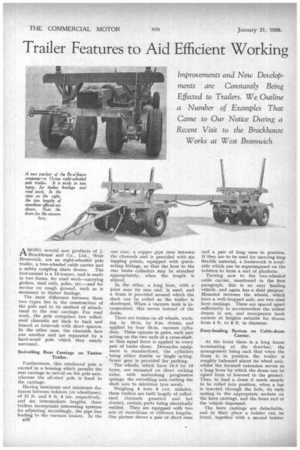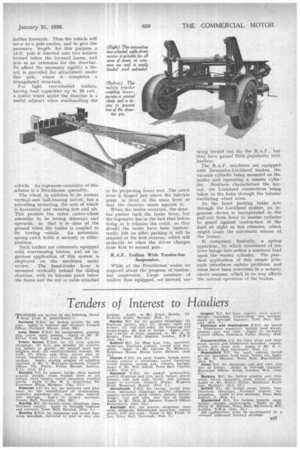Trailer Features to Aid Efficient Working
Page 22

Page 23

If you've noticed an error in this article please click here to report it so we can fix it.
Improvements and New Developments are Constantly Being Effected to Trailers. We Outline a Number of Examples That Came to Our Notice During a Recent Visit to the Brockhouse
Works at West Bromwich
A MONO several new products of J. Brockhouse and Co., Ltd., West Bromwich, are an eight-wheeled pole trailer, a two-wheeled cable carrier and a safety coupling chain device. The first-named is a 15-tonner, and is made in two forms, for road work—carrying girders, steel rails, poles, etc.—and for service on rough ground, such as is necessary in timber haulage.
The main difference between these two types lies in the construction of the pole and in its method of attachment to the rear carriage. For road work, the pole comprises two rolledsteel channels set back to back and braced at intervals with short spacers. In the other case, the channels face one another and are separated by a hard-wood pole which they pearly surround.
Swivelling Rear Carriage on Timber Trailer.
Furthermore, this reinforced pole is carried in a housing which permits the rear carriage to swivel on the pole axis, whereas the all-steel pole is fixed to the carriage.
Having maximum and minimum distances between bolsters (or wheelbases) of 21 ft. and 9 ft. 6 ins, respectively, and six intermediate lengths, these trailers incorporate interesting systems for adjusting, accordingly, the pipe line leading to the vacuum brakes. In the B36 one case, a copper pipe runs between the channels and is provided with six tapping points, equipped with quickacting fittings, so that the hose to the rear brake cylinders may be attached appropriately, when the length is altered.
In the other, a long hose, with a joint near its rear end, is used, and a drum is provided around which the slack can be coiled as the trailer is shortened. When a vacuum tank is incorporated, this serves instead of the drum.
There are brakes on all wheels, working in 16-in. by 3-in, drums, and applied by four 10-in, vacuum cylinders. These operate in pairs, each pair acting on the two ends of a cross-shaft, so that equal force is applied to every pair of brake shoes. Dewa.ndre equipment is standardized, the cylinders , being either double or single acting. Screw gear is provided for parking.
The wheels, which have 10.5 by 13 tyres, are mounted on short rocking axles, with underslung progressive springs, the swivelling axis cutting the shaft axis to minimize tyre scrub.
Weighing 4 tons 6 cwt. unladen, these trailers are built largely of rolledsteel channels gusseted and hot riveted, certain parts being electrically welded. They are equipped with two sets of stanchions of different lengths. Our picture shows a pair of short ones and a pair of long ones in position. If they are to be used for carrying long flexible material, a framework is available which can be superimposed on the bolsters to form a sort of platform.
Turning now to the two-wheeled cable carrier, mentioned in the first paragraph, this is an easy loading vehicle, and again has a dual purpose. Mounted between the wheels, which have a well-dropped axle, are two steel horn castings. These are spaced apart sufficiently to accommodate the widest drums in use, and incorporate hook sockets at heights suitable for drums from 4 ft. to 8 ft. in diameter.
Easy-loading System on Cable-drum Carrier.
At the front there is a long frame terminating at the drawbar, the arrangement being such that when the drum is in position the trailer is roughly balanced about its wheel axis, whilst the forward extension serves as a long lever by which the drum can be ra,ised from or lowered to the ground. Thus, to load a drum it needs merely to be rolled into position, when a bar is inserted through the hole, its ends resting in the appropriate sockets on the horn castings, and the front end of the vehicle depressed.
The horn castings are detachable, and in their place a bolster can be fitted, together with a second holster farther forwards. Thus the vehicle will serve as a pole carrier, and to give the necessary length for this purpose a 15-ft. pole is inserted into two sockets formed below the forward frame, and acts as an extension for the drawbar. To afford the necessary rigidity a tierod is provided for attachment under this pole, where it completes a triangulated structure.
For light two-wheeled trailers, having load capacities up to 30 cwt., a castor wheel under the drawbar is a. useful adjunct when manhandling the vehicle. An ingenious execution of this scheme is a Brockho use speciality.
The wheel, in addition to its normal vertical-axis ball-bearing swivel, has a swivelling mounting, the axis of which is horizontal and running fore and aft. This permits the entire castor-wheel assembly to be swung sideways and upwards, so that it is clear of the ground when the trailer is coupled to its towing vehicle. An automatic spring catch holds it securely in either position.
Such trailers are commonly equipped with overrunning brakes, and an ingenious application of this system is employed on the machines under review. The hand-brake lever is mounted vertically behind the sliding drawbar, with its fulcrum point below the frame and the rod or cable attached to its projecting lower end. The catch lever is hinged just above the fulcrum poiut, in front of the main lever so that the drawbar abuts against it., When When the trailer overruns, the drawbar pushes back the brake lever, but the ingenuity lies in the fact that before doing so it releases the catch, so. that should the brake have been inadvertently left on after parking it will be released at the first overrun, which will probably be when the driver changes from first to second gear.
R.A.F. Trailers With Torsion-bar Suspension.
While at the Firockhouse works we inquired about the progress of torsion. bar suspension. Large ;numbers of trailers thus equipped, we learned. are being turned out for. the ,R.A.F., but they have gained little popularity with hauliers.
The R.A.F. machines are equipped with Dewandre-Lockheed brakes, the vacuum cylinder being mounted on the trailer and operating a master cylinder. Neatness characterizes the layout, the Lockheed connections being taken to the hubs through the tubular oscillating wheel arms.
' As the hand parking brake acts through the Lockheed system, an ingenious device is incorporated in the pull-rod from lever to master cylinder to guard against contraction of the fluid at night in hot climates, which might cause the automatic release of the brakes.
It comprises, basically, a spring apparatus, by which movement of the lever brings into action a constant load 'upon the master cylinder. The practical application of this simple principle introduces certain problems, and these have been overcome in a notably clever manner, which in no way affects the normal operation of the brakes.






























